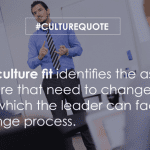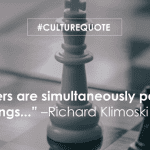Leadership Development in Context
Every leader is embedded in a complex system of relationships and processes. That system includes values and norms that energize and coordinate performance behaviors within the organization. Effective coaching requires a keen understanding of the interplay between the individual and the context. That’s why Denison helped develop the Leader-Culture Fit model for coaching.
The Leader-Culture Fit Model
A systems-oriented understanding of leadership sometimes overemphasizes the ways a leader is bound by the context, and the many ways in which context directs the occurrence and meaning of behavior by creating a set of opportunities and constraints that leaders must negotiate.
That neglects the other side of the leader-context interplay: agentic leadership. A leader’s actions and decisions directly and indirectly shape, change, and influence the context they inhabit. As Richard Klimoski reminds us, “Leaders are simultaneously pawns and kings,” bound to operate within certain constraints, but nevertheless tasked with the crucial role of changing organizations for the better.
Effective coaching requires assessment of both the context (the organization and its culture) and the leader, addressing each in light of the other. When leader’s skill strengths and weaknesses are mapped against the organization’s cultural strengths and weaknesses, the result is what we call a “Leader-Culture Fit” profile that helps you identify:
- Goals: Aspects of the culture that need to change.
- Leader-To-Context Dynamics: Where the leader will be most capable and most challenged to facilitate the change process.
- Context-to-Leader Dynamics: Ways in which the context will support or constrain the leader as an agent of change.
A coach can help the leader to recognize her potential as an agent or champion in the ongoing change process and clarify the level of involvement and role that would be most appropriate. Coaching can also help to define strategies for winning support and building key partnerships with the stakeholders of the change process, and later, explore ways to be more effective in the change-agent role.
It’s worth noting that the leader-as-agent perspective is not limited to coaching top executives. It is also applicable with mid-level leaders and even co-workers who are responsible, though perhaps to a lesser degree, for the maintenance and shaping of the organizational culture.
In a future post, we’ll talk more about multi-level assessments in Leader-Culture Fit coaching.
If would like to consult with us regarding coaching practices, or discuss your own organization’s leadership development needs, please contact us.
This post is adapted from the article “Aligning leadership and organizational culture: the leader–culture fit framework for coaching organizational leaders,” by Levi Nieminen, Benjamin Biermeier-Hanson, Daniel Denison, in Consulting Psychology Journal: Practice and Research (2013, Vol. 65, No. 3, 177–198).




